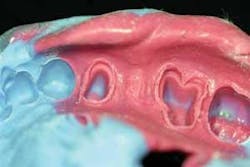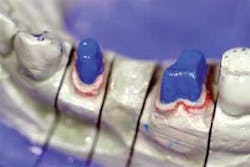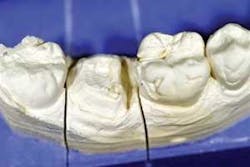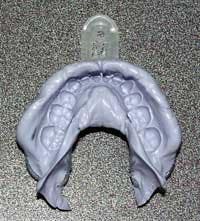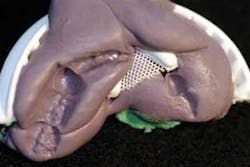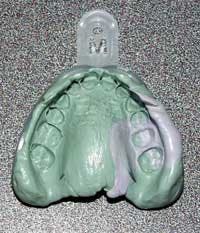The art of taking impressions
By Lori Trost, DMD, and Amos Harting, CDT
Impression taking is one of the most important procedures in dentistry - a key point in what ideally should be a predictable end result. Considered by some dentists and assistants to be one of the more stressful increments of time during a clinical procedure, impression taking involves proper tooth isolation, patient cooperation, assistant transfer, and delivery of the material. All of these steps are crucial in a successful outcome for not only the dentist and assistants, but the patient as well.
Products and technique
Impression material has really evolved and improved in the past 20 years. We have left the hand mixing of rubber base to deliver an impression material directly into a syringe. Fortunately, with better delivery systems, innovations in impression materials today have also led to shorter working times that benefit all involved. However, these time constraints make it absolutely essential for dentists and assistants to work together in order to achieve predictable results.
Besides having a proven technique in place and utilizing reliable products, the impression-taking process depends on the ability of the clinician to relay pertinent restoration information to the laboratory technician. Herein lies the differences between acceptable restorations and exceptional quality that can be delivered to the patient. For example, you prepare a tooth differently for various restorations, whether they are a 3M™ ESPE™ Lava™ Crowns and Bridges, Procera, Empress, PFM, or gold. Good laboratory technicians, however, will tell you that they often receive preparations where they have no idea as to the intended restoration.
Consider impressions to be the focal point of information delivered to the lab. Along with the preparation of the tooth, its reproduction, and replication of the surrounding tissue, teeth, and contacts, impressions assist in providing a roadmap for the technician. Properly recorded and relayed information not only yields a predictable result, but also helps to provide a successful outcome. The impression method and process should be viewed as a direct line of communication. Dentists need to realize that the impression replaces the patient’s restoration or mouth in the technician’s hands. It is then that the impression can become the ceramist’s easel.
Developing the right approach
Whatever the impression technique, you and your assistant need to take a systematic approach so there can be a synchronicity between dentist, assistant, and patient. The timing of each impression-taking phase becomes fundamental. Whether it is cord packing or removal, rinsing, preparation drying, or impression syringing, there needs to be an expected and orderly theme between team members. An example of such a procedure follows.
In my own practice, I routinely use Expa-syl™ instead of cord to isolate the margin. It is placed around the tooth margin with gentle pressure into the sulcus. That is allowed to set for a couple of minutes. The Expa-syl is then aggressively rinsed off - making sure the preparation is completely dry - before syringing the impression material around the margin. While I am doing this, my assistant is syringing the wash material in the tray and passing it to me, so no time is wasted. Remember that this type of teamwork and efficiency does not go unnoticed and actually can help increase a patient’s level of confidence in your practice. Patients observing the aforementioned procedure have commented, “Wow, that’s really great how you two work together.”
Besides developing and maintaining an efficient procedure, when taking impressions, the clinician must have a clear understanding of the products or materials to be used. Knowing where a product should and should not be applied is crucial and it is important to read the manufacturers’ suggested indications. Also remember that just because a certain product worked well for your colleague does not mean it is the best choice for you. Dentists can be quick to blame materials or a product for a disappointing result when it is often simply a matter of technique. When in doubt, read and reread the instructions that define the procedure so it can work for you.
It also is important to note differences between products. The best products are marked by consistency, performance, and predictability. Make certain a material can perform in varied environments. For example, I need to make sure a product performs as well in the August humidity as it does in the February chill. Remember too that in the patient environment, saliva and bleeding levels can impact a product’s performance, as can anatomical considerations such as structure of the jaw and tongue. In these environments, a hydrophilic material such as 3M™ ESPE™ Impregum™ Penta™Soft Impression Material would be recommended.
In the interest of maintaining your practice’s efficiency and, in turn, profitability, you do not want to waste time taking multiple impressions. As we’ve demonstrated, this can be avoided through good teamwork and open communication with your assistant, as well as maintaining a reliable clinical technique. The following are some recommendations on utilizing quality products and materials that we have found crucial in becoming a one-impression office. Note that the images below were taken from a variety of recent clinical procedures.
First and foremost is the ability to capture distinct margins (figures 1 and 2). If a margin is relayed well in an impression, the laboratory technician will have an easier time fabricating a proper-fitting restoration. Next, take into account the surrounding tissue, adjacent teeth, and occlusal table. Remember that your patients could be missing teeth and you may need an impression tray that allows for non-perfect anatomical variables. Also, symmetry needs to be recorded and relayed to the lab.
The impression tray - a key component to an easier impression-taking process
One product, relatively new to the dental marketplace, that helps make the impression-taking process easier is the 3M™ ESPE™ Directed Flow Impression Tray. The walled tray is comprised of a rigid, clear plastic that contains a fleece insert that eliminates the need for a tray adhesive and increases the stability and position of the impression material while in the tray. The tray can be placed gently in a patient’s mouth and, in addition to offering stability, also is non-obstructive. Other advantages this tray offers are a comfortable fit for the patient, true palatal form, and proper vertical height in the vestibule regions. The tray is manufactured in three sizes that are clearly marked for selection.
Impression tray choices are significant in the impression process because of their fit, form, and function. A good tray fit will not only dictate the immediate area to be recorded, but also the surrounding symmetry. While figure 3a depicts a poor example, figure 3b demonstrates a good example. Due to the manner in which the tray delivers and positions itself, and the intimate contact of the impression material to the tooth, the quality of the recorded preperation becomes a key factor. Figure 4 is a poor example. This particular rigid tray design preserves the existing occlusal table and foregoes obstruction without compromising patient comfort (figure 5). Again, these recorded relationships are vital information needed for the lab technician to produce an exceptional restoration.
Ultimately, if you are using a stable tray that keeps things positioned well and a quality material, not to mention an efficient clinical procedure, you should be well on your way toward developing reliable impressions and, in turn, consistently produced restorations. This predictability will benefit the entire practice - from the standpoint of the dentist as well as the patient. Utilizing reliable products and materials helps eliminate false starts and remakes that can result in wasted time, not to mention materials and money. The resulting high-quality restoration provides an excellent fit and will meet patient expectations. Patients also will leave your office satisfied and with a sense of confidence in your practice. This confidence helps make repeat visits and referrals possible.
Dr. Lori Trost has a thriving practice is Columbia, Ill., and is the editor of Woman Dentist Journal, a sister publication of Dental Equipment & Materials. She can be reached by e-mail at [email protected]. Amos Harting, CDT, owns and operates Harting Dental Lab Inc., a family business for more than 44 years in St. Louis, Mo.
